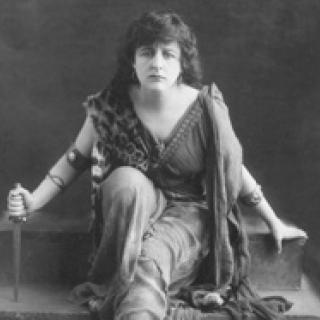Since 1996, the Library has created websites inspired by some of the physical exhibitions presented at its research centers, as well as a number of web-only presentations based on its collections.
Archived Exhibition Resources, A to Z
-
Letters to Sala
At age sixteen, Sala Garncarz entered the Nazi labor camp system, where she would be imprisoned from 1940 to 1945. During that time she was able to collect and preserve a collection of 300 letters sent to her by friends and family from outside and within the camps. The letters were recently donated to the Library''s Dorot Jewish Division by Sala's daughter, Ann Kirschner, and form the basis for the exhibition, in which they will be displayed for the first time. In passionate terms, the letters document the harsh consequences of the Nazi slave labor system on both the interned Jews and their torn families. They also reflect Sala's relationship with such noteworthy figures as Ala Gartner, one of four women hanged in Auschwitz after participating in an armed rebellion. Letters to Sala will reveal rare documentation of Nazi atrocities written by the victims of those events during the time they were unfolding.

-
Lewis Wickes Hine's "Work Portraits"
Lewis Wickes Hine's self-described "work portraits" series began shortly after World War I, when he returned from Europe after working with the American Red Cross and documenting the plight of war refugees. This time, rather than chronicling the decrepit working conditions of men, women and children in American factories, he chose instead to glorify the inextricable communion between the worker and the machine.

-
Lunch Hour NYC
Lunch Hour NYC looks back at more than a century of New York lunches, when the city’s early power brokers invented what was yet to be called “power lunch,” local charities established a 3-cent school lunch, and visitors with guidebooks thronged Times Square to eat lunch at the Automat. Drawing on materials from throughout the Library, the exhibition explores the ways in which New York City—work-obsessed, time-obsessed, and in love with ingenious new ways to make money—reinvented lunch in its own image..

-
Making the Scene: The Midtown Y Photography Gallery, 1972-1996
The Midtown Y Photography Gallery was the first non-profit organization in New York City with a mission to provide a public space for the display of photographs, helping dozens of photographers make the scene that it helped to bring about over 25 years, from 1972 to 1996 when the gallery closed.

-
Malcolm X: A Search for Truth
Based in part on the collection of personal and professional papers and memorabilia of Malcolm X deposited at the Schomburg Center, Malcom X: A Search for Truth presents a provocative and informative perspective on his life. This exhibition poses questions about the nature of the journey that Malcolm Little pursued to become El-Hajj Malik El-Shabazz, focusing on the process and products of his driving intellectual quest for truth about himself, his family, his people, his country, and his world.

-
Mapping New York's Shoreline, 1609-2009
September 2009 marks 400 years since Henry Hudson sailed into New York Harbor and up the Hudson River, almost to what is now Albany, performing detailed reconnaissance of the Hudson Valley region. Other explorers passed by the outwardly hidden harbor but did not linger long enough to fully realize the commercial, nautical, strategic, or colonial value of the region. Once the explorers returned to Europe, their strategic information was passed on to authorities. Some data was kept secret, but much was handed over to map makers, engraved on copper, printed on handmade paper, distributed to individuals and coffee-houses (the news centers of the day), and pored over by dreamers, investors, and potential settlers in the “new land.”

-
Milton Avery: The Flying Pig and Other Winged Creatures
Milton Avery (1885-1965) was one of the foremost modernist American painters, recognized for his uniquely spare style combining figurative realism and lyrical abstraction while utilizing an extraordinary sense of color. In addition to painting, Avery produced nearly sixty drypoints, lithographs, and woodcuts in sporadic periods from 1933 to 1963. In 1946, at the instigation of his friend, painter Mark Rothko, Avery created his only illustrations: a set of eight witty and colorful gouache paintings for a children's book entitled Paul, which remained unpublished during the artist's lifetime.

-
Mirrors to the Past: Ancient Greece and Avant-garde America
This multimedia exhibition, which draws on rare material housed in all four research divisions of The New York Public Library for the Performing Arts, focuses on the liberating force of archaic and classical Greece and the countless 20th-century American choreographers, theater artists, composers, visual artists, and designers it inspired.

-
Moving Uptown: Nineteenth-century Views of Manhattan
Moving Uptown traces Manhattan's urban evolution as it has been recorded in 19th-century prints, drawn primarily from the Eno Collection of New York City Views and the I. N. Phelps Stokes Collection of American Historical Prints, both gifts to the Library's Print Collection of the Miriam and Ira D. Wallach Division of Art, Prints and Photographs. These views rarely dwell on any of the disturbing social repercussions of the city's remarkable growth (that was primarily the purview of illustrated journals), but rather they celebrate the ever-changing face of a thriving, bustling, confident city.

-
Multiple Interpretations: Contemporary Prints in Portfolio at The New York Public Library
Prints by definition suggest multiplicity, and printmaking lends itself to projects that are best expressed through multiple images. The artists represented in this exhibition have taken advantage of printmaking's penchant for serial imagery in order to tell a story, to take a stand on political and social concerns, to consider formal issues, and to explore the creative process.
